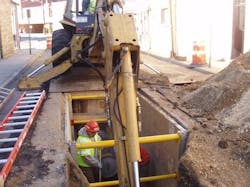Trench construction is the perfect amalgamation of all four of OSHA’s top construction hazards: falling, being struck by a vehicle or materials, getting caught in between structures, and electrocution. Drill down into each of these general hazards and the number of opportunities for injury or death from each danger multiplies. Often, one hazard contributes to another incident, such as a worker falling into a trench followed by a sudden shift of the trench walls, trapping the worker.
Todd Petersen is a trench-safety instructor at the Apprentice and Skill Improvement Program run by Local 150 of the International Union of Operating Engineers in Wilmington, Ill. He says that while all construction categories carry hazards particular to their type, trenching is especially hazardous.
“Trenching is an intensely human job because everyone’s actions and attitudes on the trench site are potentially lifesaving or life threatening,” Petersen says. “It is easy for an employer to assume that because a worker has done a similar job before without incident, he’ll know enough to prevent an accident on the next, somewhat different job.”
Unfortunately, that assumption may be a killer. “Workers can have different levels of trench-safety knowledge depending on their location, experience and trade,” says Petersen. “Working safely in trenching requires a team effort, everyone being responsible for the other’s wellbeing. But if the man standing next to you hasn’t had the experience or isn’t aware of possible dangers in the trench, his position in the team can weaken the job.”
Although OSHA requires all workers have trench-safety training before beginning a job, there is no national standard training format contractors must follow. Workers trained in a union setting may understand safe trench practices differently than workers who received training from a small company. This variation in safety skills can also carry over to other trades’ safety expertise, such as excavator operations. For this reason, Petersen suggests the contractor have the competent person assigned to the job evaluate each worker’s understanding of the hazards their part of the job may present. The evaluations can be used to gear specific pre-project training before the job begins.
Read also: Quick-coupler safety tips
Petersen says that this is especially important if new hires for the job have come from areas of the country where trench-safety education is not readily available or if English is not the worker’s first language. The Department of Labor estimates three out of five trench injuries happen to foreign-born workers.
Dave Benjamin, executive director of the Underground Contractors Association of Illinois, says another major part of trench safety is preventing cave-ins, which represent 70 percent of trench accidents, according to OSHA. He says the the competent person’s soil classifications training is key to preventing conditions that lead to cave-ins.
“Dirt failure, especially where the ground has been worked previously such as in urban areas and where trenches may intersect, are ‘live’ sites that are continuously changing as the trenching project progresses,” he says. Misjudging soil types can lead to inadequate or incorrect installation of safety devices such as shoring or trench boxes. “The competent person assigned to a job should have a thorough understanding of soil properties and behaviors, and be able to read the trench site for changes that affect shoring systems, fissure and crack development, and the stability of adjacent structures.”
OSHA does not require the competent person to be onsite at all times, so some contractors are borrowing from other industries’ safety procedures to protect workers. Benjamin says these contractors are building in procedures similar to manufacturing’s lock-out/tag-out practices as part of their operator’s daily set up.
“Any kind of visual or audio reminder that is supported by a physical action will reinforce the operator’s safety training,” Benjamin says. “An example I’ve seen is a large tag with specific tasks fastened to the excavator operator’s seat. The operator must complete the task described on the tag, such as checking if attachments are locked in position, then give the tag to a designated person before he signs out the machine for the day.” The procedure would be reversed at the end of the day. Similar procedures are also being used to protect workers from stored-energy hazards found in equipment with secondary power sources.
Another layer of protection is coming from equipment manufacturers. Jon Kuyers, product manager, underground segment, at Vermeer says he has seen an increase in trench safety over the past several years, partially due to rising penalties imposed by OSHA and insurance companies.
“Better-designed equipment takes the opportunity for injuries away from the jobsite,” Kuyers says. He points to features such as operator-presence systems that shut down hydraulic functions when the operator leaves his station. “More logic is being written into the machine’s control programs to make sure the equipment has no way to function without the operator.
“Safety is an expense,” he says. “Taking time for training, providing personal protection gear for each worker, surrounding the jobsite with soil fortification, and investing in better-designed equipment adds to the company’s operating costs and the project owner’s bottom line.”
But Kuyers makes this argument, “Safety features on trenching equipment and extensive training on safe working procedures cost money, but they also lessen the risk of workers’ injuries and company liability complaints. In this case, creating the lowest risk provides the greatest return.”
